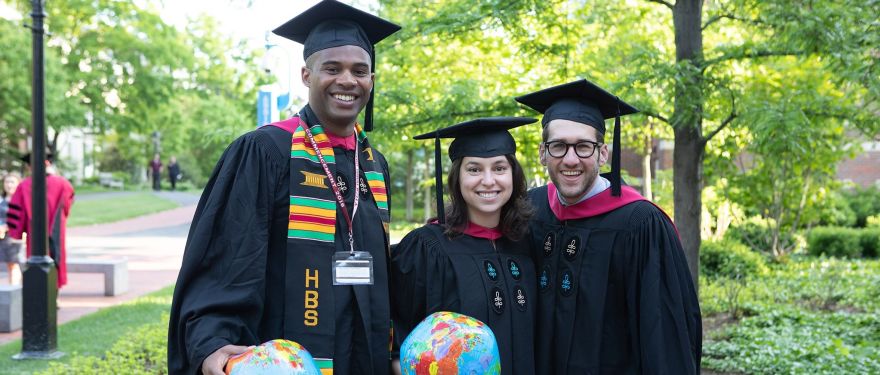International students make up 37% of the Class of 2023. While some of these students will return to their home country or region to work after graduating, many choose to accept a full-time role in the United States.
Whatever career path international students choose to pursue, the HBS Career and Professional Development Office (CPD) provides resources, guidance, and access to job opportunities.
Phillip Andrews, a Corporate Relations Director and Career Coach in CPD, has been working with international students for the last seven years. We checked in with him to learn more about what international students should know about working in the U.S. after business school.

Do many international students choose to work in the U.S. after business school?
Yes, many do. In the Class of 2019, 65% of international students who sought a full-time position at graduation accepted a job in the U.S.
How do international students approach the U.S. job search?
As a student, it is important to understand the timing of recruiting for a given industry or company, and the degree of networking that you will have to undertake in the job search, so you can plan your approach and set a strategy. Based on a given student’s unique career vision, they are going to utilize different approaches to the job search, and a lot of this revolves around timing. Some companies, typically the large MBA employers – such as large consulting, financial services, and tech firms – recruit second-year students early in the academic year (September – November). Other organizations recruit students throughout the winter (December – February), while still others recruit in the spring closer to graduation (March – May).
What would you like international students to know about CPD?
One of our most valuable resources for students is our Career Coaching program (we have more than 55 coaches!) who work with students 1 on 1 to help them sharpen their career vision, navigate the job search, and perfect their pitch. Overall, there is substantial CPD support in place for international students seeking to work in the U.S. CPD uses a job search framework to help students think about the job search: “Discover, Source and Pitch”. First, you need to discover what interests you. Then, you need to find opportunities that align with your career interests, and finally, you need to pitch yourself for those opportunities. Using this framework, CPD helps international students who are looking to work in the U.S. after graduation discover what organizations are open to sponsoring work authorization in the U.S. and how to pitch themselves and their unique skills to those U.S. employers.
Is it easier for international students to get work visas at larger companies?
The most common, and sought after, long-term skilled visa category in the U.S. is the H-1B Temporary Specialty Worker classification. H-1B visas do require sponsorship from the employer and are granted through an annual lottery system. Since the process is truly a random lottery, the size or type of company has no bearing on a student’s likelihood of receiving the visa. What is more important is that the job closely aligns with the student’s unique skill set. While a large company may have sponsored H-1B visas more often than a smaller firm – simply because a larger company hires more people – and therefore is more familiar with the process, the larger company has no advantage over the smaller, earlier stage company. We have observed that smaller, earlier stage companies are increasingly willing to pursue visa sponsorship and secure H-1B visas through the lottery. Perhaps this is because these firms are more comfortable with risk and understand the value of an international perspective.
How does the alumni network impact the job search for international students?
The HBS alumni network is vast and incredibly connected. I find that non-U.S. alumni working in the U.S. are often very eager to help students from their same home country or region with the U.S. job search, from networking and to sourcing an opportunity in a company to understanding an organization’s culture and career trajectory in the U.S.
What visa options are available for students who wish to stay in the U.S.?
Non-U.S. students hold either F-1 or J-1 visa status and are automatically eligible to work in the U.S. immediately after graduation for 12 months (F-1) to 18 months (J-1) without requiring company sponsorship. In addition, many F-1 students opt into the Management Science track through course selection and demonstrate a commitment to STEM-focused careers. An added benefit is eligibility for a two-year extension of their Optional Practical Training (OPT). When paired with a STEM designated role after HBS, this academic track qualifies F-1 international students for a total of 36 months of work authorization in the U.S. after graduating. Longer term U.S. work authorization is available through the H-1B visa which does require company sponsorship. Other visa options include L-1 intra-company Transferee, TN Professional Worker (available to Canadians and Mexicans working in certain fields), and E-3 U.S.-Australia Free Trade Agreement Professional Worker (available to Australians), amongst others.

